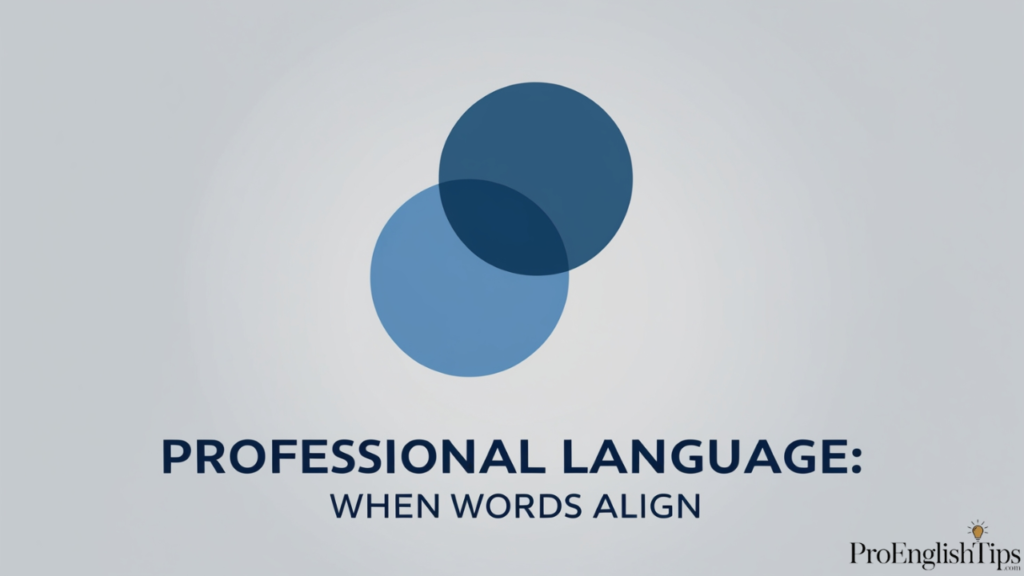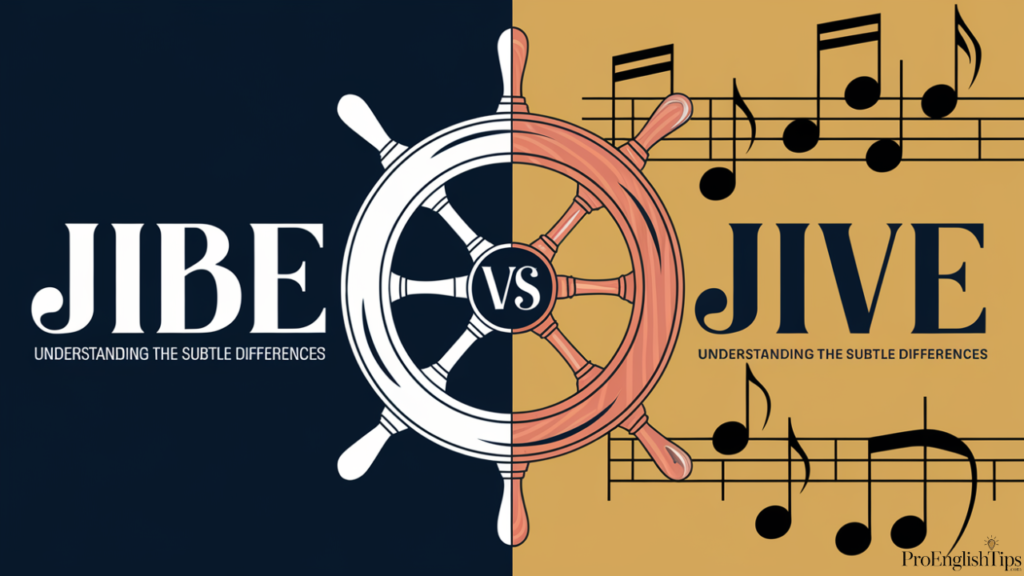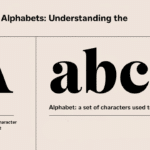Words that sound similar yet carry distinct meanings often lead to confusion in everyday communication. The terms jibe and jive represent a classic example of word confusion that challenges both native and non-native English speakers.
Understanding these word pairs through proper word disambiguation helps maintain communication accuracy in various contexts.
The Nautical Origins of Jibe

The word jibe, rooted in nautical terminology, primarily refers to the act of shifting a sail from one side to another when sailing downwind. In modern language precision, it has evolved to mean “to be in accordance with” or “to agree with something.” This semantic difference from its original meaning demonstrates how language harmony develops over time.
| Common Nautical Terms | Meaning | Related Actions |
|---|---|---|
| Jibe | Shift sail direction | Change course |
| Tack | Change direction upwind | Adjust sails |
| Port | Left side of vessel | Navigate left |
| Starboard | Right side of vessel | Navigate right |
| Helm | Steering mechanism | Control direction |
| Bow | Front of ship | Move forward |
| Stern | Back of ship | Reverse motion |
| Keel | Bottom centerline | Maintain stability |
| Mast | Vertical spar | Support sails |
| Hull | Main body | Float vessel |
The Musical Roots of Jive

In contrast, jive emerges from musical terminology and jazz dance culture of the 1920s. This word choice guide reveals how it originally described a lively form of swing dance and later evolved to represent deceptive talk or misleading speech patterns in informal speech contexts.
| Jazz Era Terms | Original Meaning | Modern Usage |
|---|---|---|
| Jive | Swing dance style | Foolish talk |
| Swing | Dance movement | Rhythm type |
| Bebop | Jazz style | Fast tempo |
| Scat | Vocal improvisation | Nonsense words |
| Blues | Musical form | Melancholy mood |
| Groove | Rhythm pattern | Good feeling |
| Cool | Temperature | Fashionable |
| Hip | Body part | Trendy |
| Cat | Animal | Jazz musician |
| Gig | Performance | Temporary job |
Contextual Usage in Modern Communication
The writing clarity of your message often depends on proper word alignment. When we examine usage examples in contemporary communication, we find distinct patterns in how these terms function in professional versus casual settings.
Professional Communication Examples

Sarah Thompson, a marketing director, demonstrates proper language differentiation in her email to the development team:
“Our new campaign strategy doesn’t jibe with our company’s core values. We need to realign our messaging.”
| Professional Context | Jibe Usage | Jive Usage |
|---|---|---|
| Business Reports | Align with data | Rarely used |
| Policy Documents | Match guidelines | Not appropriate |
| Legal Briefs | Conform to law | Never used |
| Team Emails | Agree with goals | Informal only |
| Project Plans | Fit timeline | Avoid usage |
| Meeting Minutes | Match discussion | Not recommended |
| Client Communication | Correspond to needs | Unprofessional |
| Strategy Documents | Align with mission | Not suitable |
| Performance Reviews | Match expectations | Inappropriate |
| Corporate Policies | Accord with values | Never formal |
Social Media and Informal Settings
In slang expressions and informal communication, linguistic comparison shows how these similar sounding words serve different purposes. Through proper word disambiguation, we can better understand their contextual usage.
| Social Context | Common Usage | Example Phrase |
|---|---|---|
| Text Messages | Both terms | “Stop jiving me!” |
| Twitter Posts | Mostly jive | “That’s pure jive” |
| Facebook Updates | Mixed usage | “Doesn’t jibe right” |
| Instagram Captions | Casual jive | “Jiving with friends” |
| Blog Posts | Context-dependent | “Ideas that jibe” |
| YouTube Comments | Informal jive | “Stop that jive talk” |
| Reddit Threads | Both accepted | “Facts don’t jibe” |
| Chat Groups | Casual usage | “Jiving all night” |
| Forum Posts | Mixed usage | “Theory jibes with” |
| Personal Emails | Context-based | “Plans jibe well” |
Understanding Through Real-World Scenarios
The homophones jibe and jive create interesting scenarios in daily communication. Consider this email exchange between Professor James Wilson and his colleague about research findings:
“Dear Dr. Martinez, The new data doesn’t jibe with our initial hypothesis. We should review the methodology.”
Common Scenarios and Corrections
Here’s how these terms manifest in various communication scenarios, highlighting the importance of word choice guide principles and communication accuracy.
| Communication Type | Correct Usage | Common Mistake |
|---|---|---|
| Academic Papers | Data jibes with | Data jives with |
| Business Proposals | Plan jibes with | Plan jives with |
| Technical Reports | Results jibe | Results jive |
| Meeting Notes | Ideas jibe | Ideas jive |
| Project Updates | Goals jibe | Goals jive |
| Research Analysis | Findings jibe | Findings jive |
| Status Reports | Progress jibes | Progress jives |
| Quality Checks | Standards jibe | Standards jive |
| Feedback Forms | Comments jibe | Comments jive |
| Assessment Reports | Metrics jibe | Metrics jive |
Digital Communication and Social Media

Modern speech patterns in digital spaces have created new challenges in maintaining language precision. Social media platforms and instant messaging have influenced how these terms are used in informal speech.
| Platform Type | Typical Usage | Acceptance Level |
|---|---|---|
| LinkedIn Posts | Professional jibe | High formal |
| Snapchat Messages | Casual jive | High informal |
| WhatsApp Groups | Mixed usage | Context-based |
| Discord Servers | Gaming jive | Very informal |
| Slack Channels | Work-appropriate | Semi-formal |
| Teams Messages | Professional | Formal |
| Zoom Chats | Context-dependent | Mixed |
| TikTok Content | Casual jive | Very informal |
| Pinterest Descriptions | Style-dependent | Mixed |
| Medium Articles | Professional | Formal |
Mastering the Distinction
Understanding the semantic difference between these terms enhances our ability to communicate effectively. In professional settings, using “jibe” indicates agreement or alignment, while “jive” might suggest a more casual or potentially misleading interaction. This distinction in word usage comparison becomes crucial for maintaining professional credibility.
Remember that language harmony often depends on understanding these subtle differences. Whether you’re writing a formal report or engaging in casual conversation, proper word choice can significantly impact how your message is received. The key to mastering these terms lies in recognizing their distinct origins – one from nautical terminology and the other from musical terminology – and applying them appropriately in modern contexts.
Through careful attention to these linguistic nuances and common word mistakes, we can improve our communication accuracy and avoid confusion in both written and spoken English. As language continues to evolve, staying aware of these distinctions helps maintain clarity and precision in all forms of communication.
The Impact of Cultural Context
The evolution of language harmony shows how words adapt across different cultural contexts. In American English, jive gained prominence during the jazz era, becoming associated with informal speech and deceptive talk. Meanwhile, British English maintained a more traditional approach to these word pairs.
Regional Variations and Usage
Understanding regional differences helps prevent common word mistakes in international communication. Different English-speaking regions show varying preferences in their speech patterns.
| Region | Preferred Term | Cultural Context |
|---|---|---|
| American South | Jive talking | Informal slang |
| British Isles | Jibe with | Formal agreement |
| Australian | Jibe together | Casual alignment |
| Canadian | Both forms | Context dependent |
| Caribbean | Jive culture | Music related |
| New Zealand | Jibe with | General agreement |
| South African | Jibe along | Casual agreement |
| Irish English | Gibe variant | Teasing context |
| Scottish English | Jibe mostly | Agreement focus |
| Indian English | Formal jibe | Professional use |
Digital Age Communication
Modern communication platforms have influenced word usage comparison significantly. Professional networking sites maintain formal language while social media embraces informal expressions.
| Digital Platform | Common Usage | Professional Impact |
|---|---|---|
| Work Email | Jibe preferred | High importance |
| Social DMs | Jive common | Low importance |
| Blog Posts | Context based | Medium impact |
| News Articles | Formal jibe | High visibility |
| Forum Posts | Mixed usage | Varied impact |
| Professional Bios | Formal jibe | Career critical |
| Chat Messages | Casual jive | Minimal impact |
| Video Scripts | Purpose based | Public facing |
| Podcast Notes | Style dependent | Brand aligned |
| Website Copy | Market specific | SEO sensitive |
Writing Guidelines for Clarity
The pursuit of writing clarity requires understanding both terms’ proper application. For professional writers, editors, and content creators, maintaining language precision becomes crucial for effective communication.
Professional Writing Standards
Contemporary professional writing demands careful word disambiguation to maintain credibility. Consider these real-world applications from various industries:
| Industry Sector | Standard Usage | Example Context |
|---|---|---|
| Legal Documents | Formal jibe | Contract terms |
| Medical Reports | Clear alignment | Patient records |
| Technical Specs | Precise matching | Engineering docs |
| Financial Reports | Data agreement | Audit findings |
| Marketing Copy | Brand alignment | Campaign goals |
| Academic Papers | Research correlation | Study results |
| HR Documents | Policy compliance | Employee guides |
| Sales Proposals | Value proposition | Client needs |
| Product Manuals | Specification match | User guidance |
| Quality Reports | Standard compliance | Inspection notes |
The Role of Natural Language Processing
Modern word disambiguation tools employ sophisticated algorithms to understand contextual usage. This technological advancement helps writers maintain communication accuracy across various platforms.
| NLP Application | Purpose | Impact on Writing |
|---|---|---|
| Content Analysis | Context detection | Better accuracy |
| Grammar Checking | Error prevention | Fewer mistakes |
| Style Assessment | Tone consistency | Brand alignment |
| Readability Score | Clarity measure | User friendly |
| Context Detection | Meaning clarity | Precise usage |
| Sentiment Analysis | Tone evaluation | Appropriate feel |
| Error Prediction | Mistake prevention | Quality control |
| Usage Tracking | Pattern analysis | Style guidance |
| Automated Editing | Quick fixes | Time saving |
| Learning Patterns | Improvement help | Skill building |
Future Trends in Language Usage
As communication continues to evolve, understanding how these terms adapt becomes increasingly important for maintaining language harmony. New technologies and social media platforms influence how we use and interpret these words.
Emerging Communication Patterns
The digital age brings new challenges to word choice guide principles. Social media and instant messaging create unique contexts for language usage.
| Communication Trend | Impact on Usage | Future Outlook |
|---|---|---|
| Virtual Reality Chat | Mixed formats | Expanding usage |
| AI Communication | Formal preference | Growing precision |
| Voice Commands | Clear distinction | Important clarity |
| Digital Assistants | Programmed usage | Standardization |
| Social Networks | Context dependent | Evolving norms |
| Professional Tools | Formal standards | Strict guidelines |
| Education Platforms | Teaching focus | Clear distinction |
| Global Networks | Cultural awareness | Adaptive usage |
| Remote Teams | Professional tone | Formal preference |
| Digital Marketing | Brand appropriate | Strategic choice |
The distinction between jibe and jive continues to evolve with our changing communication landscape. Understanding these changes helps writers and speakers maintain clarity while adapting to new contexts. Whether in professional documents or casual conversation, choosing the right word strengthens your message and ensures effective communication across all platforms and situations.
Educational Applications and Teaching Methods
Teaching the proper contextual usage of these terms requires careful attention to language differentiation. Modern educators employ various techniques to help students understand semantic difference in practical situations.
Classroom Implementation Strategies
Professor Maria Rodriguez, a linguistics expert at Stanford University, demonstrates how word disambiguation can be taught effectively through real-world scenarios rather than mere memorization.
| Teaching Method | Learning Outcome | Student Engagement |
|---|---|---|
| Role-play Scenarios | Practical usage | High involvement |
| Written Exercises | Grammar mastery | Focused practice |
| Digital Quizzes | Quick assessment | Interactive learning |
| Group Discussions | Peer learning | Active participation |
| Video Analysis | Context recognition | Visual learning |
| Case Studies | Applied knowledge | Critical thinking |
| Language Games | Fun learning | High motivation |
| Writing Workshops | Practical application | Skill development |
| Presentation Tasks | Speaking practice | Confidence building |
| Online Forums | Extended practice | Self-directed study |
Assessment and Evaluation
Understanding how students grasp these word pairs helps educators refine their teaching approaches for better language harmony.
| Assessment Type | Evaluation Focus | Success Metric |
|---|---|---|
| Written Tests | Usage accuracy | Score percentage |
| Speaking Tasks | Contextual use | Fluency level |
| Project Work | Applied knowledge | Project quality |
| Peer Review | Usage feedback | Improvement rate |
| Self-Assessment | Learning awareness | Progress tracking |
| Portfolio Review | Overall growth | Skill development |
| Online Quizzes | Quick checks | Instant feedback |
| Group Projects | Collaborative use | Team performance |
| Presentations | Public speaking | Delivery quality |
| Final Essays | Comprehensive use | Writing proficiency |
Professional Development and Style Guides
Corporate training programs often emphasize the importance of proper word choice guide principles for maintaining professional credibility.
Corporate Communication Standards
Major organizations develop specific guidelines for language precision in various communication contexts.
| Document Type | Style Rule | Business Impact |
|---|---|---|
| Annual Reports | Formal jibe | Investor confidence |
| Press Releases | Context specific | Public perception |
| Internal Memos | Clear guidance | Team alignment |
| Client Proposals | Professional tone | Business success |
| Training Materials | Clear examples | Staff development |
| Brand Guidelines | Usage rules | Brand consistency |
| Social Media | Platform specific | Online presence |
| Customer Service | Situation based | Service quality |
| Legal Documents | Strict standards | Legal compliance |
| Marketing Copy | Brand voice | Market response |
Industry-Specific Applications
Different sectors have unique requirements for maintaining communication accuracy in their documentation.
| Industry | Usage Protocol | Key Consideration |
|---|---|---|
| Healthcare | Patient clarity | Medical accuracy |
| Technology | Technical precision | User understanding |
| Education | Teaching clarity | Learning outcomes |
| Finance | Data accuracy | Regulatory compliance |
| Hospitality | Customer focus | Service quality |
| Manufacturing | Safety emphasis | Operation precision |
| Retail | Sales language | Customer engagement |
| Media | Style guidelines | Audience reach |
| Construction | Safety protocols | Project clarity |
| Aviation | Standard terms | Safety compliance |
The Role of Technology in Language Evolution
Modern technology influences how we understand and use these terms through sophisticated word disambiguation tools.
Digital Tools and Resources
AI-powered writing assistants help maintain language precision across various platforms and contexts.
| Tool Type | Primary Function | User Benefit |
|---|---|---|
| Grammar Apps | Usage check | Error prevention |
| Style Checkers | Tone analysis | Consistency help |
| Writing AI | Suggestion engine | Improvement guide |
| Language Models | Context analysis | Better accuracy |
| Translation Tools | Cross-language help | Global reach |
| Learning Apps | Practice exercises | Skill building |
| Digital Dictionaries | Quick reference | Clear definitions |
| Content Analyzers | Quality check | Better writing |
| Editing Software | Comprehensive review | Professional polish |
| Readability Tools | Clarity assessment | Improved impact |
Conclusion
The distinction between jibe and jive represents more than just a case of similar sounding words. It reflects the rich complexity of English language evolution, from nautical terminology to musical terminology, and into modern digital communication.
Understanding these terms through proper word usage comparison helps writers and speakers maintain clarity across all contexts. Whether in professional documents demonstrating writing clarity or casual conversations showing linguistic comparison, choosing the right word strengthens communication and ensures your message achieves its intended impact.
As language continues to evolve through informal speech and formal documentation, staying aware of these subtle differences helps maintain effective communication. The future of language harmony depends on our ability to adapt to changing contexts while preserving the precise meaning and appropriate usage of these important word pairs.
Remember that deceptive talk often stems from misunderstanding these subtle language distinctions. By mastering the proper use of these terms, we can ensure our communication remains clear, effective, and appropriate across all contexts and situations.
Practical Communication Templates
Understanding language differentiation becomes easier when we examine real-world templates across various communication channels. These examples demonstrate proper word alignment in different contexts.
Business Email Templates
Marketing Director Alexandra Chen demonstrates perfect word choice guide implementation in her team communications:
“Dear Development Team,
I’ve reviewed the latest campaign materials. While the creative direction jibes with our brand guidelines, we need to ensure all messaging maintains this alignment across platforms.”
| Email Purpose | Correct Template | Context |
|---|---|---|
| Project Alignment | Our timeline jibes with | Schedule discussion |
| Strategy Review | The approach jibes perfectly | Planning meeting |
| Data Analysis | These numbers don’t jibe | Report review |
| Team Feedback | Your suggestions jibe well | Performance review |
| Client Response | Our vision jibes with | Proposal follow-up |
| Budget Discussion | Costs jibe with estimates | Financial planning |
| Quality Check | Results jibe with standards | Compliance review |
| Partnership Update | Goals jibe together | Collaboration note |
| Resource Planning | Requirements jibe with | Capacity planning |
| Innovation Brief | Concepts jibe nicely | Creative direction |
Social Media Guidelines
Modern speech patterns require careful attention to contextual usage across different platforms.
| Platform | Professional Post | Casual Post |
|---|---|---|
| Project jibes with goals | Avoid jive talk | |
| Plans jibe perfectly | Jiving with crew | |
| Ideas jibe together | Weekend jive | |
| Vision jibes with brand | Dance jive time | |
| YouTube | Content jibes well | Jive tutorial |
| Style jibes with trend | Jive culture | |
| TikTok | Skills jibe together | Jive moves |
| Theory jibes with data | Jive comments | |
| Discord | Strategy jibes well | Jive chat |
| Snapchat | Goals jibe perfectly | Pure jive |
Academic Writing Standards
Professor Williams demonstrates proper semantic difference in scholarly communication:
“The experimental results jibe with our theoretical framework, suggesting a strong correlation between the observed phenomena.”
| Document Type | Usage Example | Purpose |
|---|---|---|
| Research Paper | Data jibes with theory | Results discussion |
| Literature Review | Studies jibe together | Research synthesis |
| Methodology | Approach jibes with | Design explanation |
| Discussion Section | Findings jibe well | Analysis presentation |
| Conference Abstract | Results jibe with | Research summary |
| Grant Proposal | Goals jibe perfectly | Funding request |
| Peer Review | Analysis jibes with | Paper evaluation |
| Thesis Statement | Arguments jibe well | Research focus |
| Journal Article | Evidence jibes with | Scientific proof |
| Research Brief | Conclusions jibe | Study overview |
Professional Report Templates
These templates demonstrate proper word disambiguation in formal documentation:
| Report Section | Proper Usage | Incorrect Usage |
|---|---|---|
| Executive Summary | Findings jibe with | Findings jive with |
| Data Analysis | Numbers jibe well | Numbers jive well |
| Recommendations | Solutions jibe with | Solutions jive with |
| Market Research | Trends jibe together | Trends jive together |
| Financial Review | Projections jibe | Projections jive |
| Risk Assessment | Analysis jibes with | Analysis jives with |
| Strategy Overview | Plans jibe perfectly | Plans jive perfectly |
| Performance Review | Results jibe with | Results jive with |
| Quality Assurance | Standards jibe well | Standards jive well |
| Implementation Plan | Methods jibe with | Methods jive with |
Technical Documentation Guide
Maintaining language precision in technical writing ensures optimal communication accuracy:
| Document Type | Standard Format | Example Context |
|---|---|---|
| API Reference | Parameters jibe | Integration guide |
| User Manual | Functions jibe with | Usage instructions |
| Code Comments | Logic jibes with | Development notes |
| Release Notes | Updates jibe with | Version changes |
| System Design | Components jibe | Architecture docs |
| Test Cases | Results jibe well | QA reporting |
| Bug Reports | Behavior jibes | Issue tracking |
| Config Guide | Settings jibe | Setup instructions |
| Security Docs | Protocols jibe | Safety standards |
| Migration Guide | Steps jibe with | Update process |
Client Communication Framework
Effective client interaction requires careful attention to word choice guide principles:
| Communication Type | Professional Phrase | Purpose |
|---|---|---|
| Proposal Response | Solution jibes with | Client needs |
| Progress Update | Timeline jibes well | Project status |
| Feedback Request | Changes jibe with | Revision check |
| Strategy Brief | Approach jibes | Planning align |
| Budget Discussion | Costs jibe together | Financial talk |
| Milestone Report | Progress jibes | Status update |
| Quality Review | Standards jibe with | Performance check |
| Contract Terms | Agreement jibes | Legal clarity |
| Service Level | Metrics jibe well | Performance goal |
| Partnership Brief | Goals jibe perfectly | Collaboration plan |
These templates and examples serve as practical guides for maintaining language harmony across various professional contexts. They demonstrate how proper word usage comparison can enhance communication effectiveness while avoiding common word mistakes. Remember that language precision often determines professional credibility, making these distinctions crucial for successful communication.
Advanced Writing Scenarios
Understanding word pairs in complex professional situations requires careful attention to language harmony. Let’s explore some sophisticated applications that demonstrate proper word choice guide principles.
International Business Communication
Senior Operations Director James Chen demonstrates excellent language differentiation in cross-cultural business contexts:
“Our Asian market strategy jibes perfectly with our global expansion goals, while maintaining regional sensitivity.”
| Business Context | Global Usage | Local Adaptation |
|---|---|---|
| Market Entry | Strategy jibes | Cultural alignment |
| Partner Relations | Goals jibe with | Local customs |
| Supply Chain | Operations jibe | Regional practices |
| Brand Position | Values jibe well | Market specifics |
| Customer Service | Standards jibe | Local expectations |
| Team Management | Methods jibe with | Cultural norms |
| Risk Assessment | Protocols jibe | Regional factors |
| Quality Control | Metrics jibe well | Local standards |
| Product Launch | Timeline jibes | Market timing |
| Growth Strategy | Plans jibe with | Regional goals |
Crisis Communication Framework
Professional communicators must maintain writing clarity during challenging situations:
| Crisis Type | Appropriate Usage | Communication Goal |
|---|---|---|
| PR Emergency | Response jibes with | Public trust |
| Safety Incident | Actions jibe well | Clear guidance |
| Product Recall | Plan jibes with | Customer safety |
| Service Outage | Updates jibe well | User confidence |
| Employee Issue | Policy jibes with | Staff clarity |
| Market Change | Strategy jibes | Stakeholder trust |
| Legal Challenge | Statement jibes | Legal compliance |
| Media Crisis | Message jibes with | Public relations |
| Tech Failure | Solutions jibe | User support |
| Brand Issue | Actions jibe well | Trust restoration |
Technical Implementation Guide
Software Development Manager Sarah Martinez shows perfect semantic difference implementation:
| Development Phase | Usage Example | Technical Context |
|---|---|---|
| Requirements | Specs jibe with | Project scope |
| Architecture | Design jibes with | System structure |
| Code Review | Logic jibes well | Development standards |
| Testing Phase | Results jibe with | Quality assurance |
| Deployment | Process jibes | Release management |
| Documentation | Guides jibe with | User support |
| Maintenance | Updates jibe well | System stability |
| Security Check | Controls jibe | Safety protocols |
| Performance | Metrics jibe with | Speed requirements |
| Integration | Systems jibe well | Connection points |
Content Marketing Strategy
Understanding contextual usage in marketing communications ensures message effectiveness:
| Content Type | Strategic Usage | Marketing Goal |
|---|---|---|
| Brand Story | Values jibe with | Audience connection |
| Campaign Copy | Message jibes | Market impact |
| Social Posts | Tone jibes well | Engagement boost |
| Blog Articles | Topics jibe with | SEO performance |
| Video Scripts | Style jibes | Brand consistency |
| Email Content | Offers jibe well | Conversion rate |
| Landing Pages | Design jibes | User experience |
| Case Studies | Results jibe with | Proof points |
| Whitepapers | Research jibes | Authority building |
| Newsletters | Content jibes well | Reader value |
Legal Documentation Standards
Maintaining language precision in legal contexts prevents potential misunderstandings:
| Document Type | Correct Format | Legal Purpose |
|---|---|---|
| Contracts | Terms jibe with | Agreement clarity |
| Compliance | Rules jibe well | Regulatory fit |
| Privacy Policy | Standards jibe | Data protection |
| Terms of Use | Conditions jibe | User agreement |
| Patents | Claims jibe with | Protection scope |
| Legal Briefs | Arguments jibe | Case support |
| Settlements | Terms jibe well | Dispute resolution |
| Regulations | Rules jibe with | Legal framework |
| Agreements | Clauses jibe | Party obligations |
| Warranties | Coverage jibes | Product protection |
Human Resources Communications
Professional HR communication requires careful word disambiguation:
| HR Function | Proper Usage | Professional Impact |
|---|---|---|
| Job Listings | Requirements jibe | Talent attraction |
| Performance Reviews | Goals jibe with | Employee growth |
| Policy Updates | Rules jibe well | Staff compliance |
| Benefits Info | Plans jibe with | Employee satisfaction |
| Training Materials | Content jibes | Skill development |
| Team Building | Activities jibe | Culture building |
| Conflict Resolution | Solutions jibe | Harmony restoration |
| Career Planning | Paths jibe with | Growth alignment |
| Compensation | Structure jibes | Fair treatment |
| Diversity Goals | Actions jibe well | Inclusive culture |
These advanced scenarios demonstrate how proper word usage comparison strengthens professional communication across various specialized contexts. Whether in legal documentation, technical writing, or strategic planning, understanding these linguistic nuances helps maintain communication accuracy and professional credibility.
The key to mastering these distinctions lies in recognizing that while informal speech might occasionally embrace “jive” in casual settings, professional contexts almost universally call for “jibe” when indicating alignment or agreement. This understanding of word pairs helps prevent common word mistakes and ensures clear, effective communication in all professional situations.
Consider how these examples demonstrate the evolution from traditional nautical terminology to modern business language, while maintaining precise meaning and appropriate contextual usage. This attention to language precision ultimately contributes to better understanding and more effective professional relationships across all sectors and situations.
Real-World Implementation Cases
Understanding language differentiation through practical examples helps professionals maintain proper word alignment in various situations. Let’s examine some detailed case studies that demonstrate effective communication accuracy.
Corporate Rebranding Project
Chief Marketing Officer Rachel Thompson faced a significant challenge during her company’s global rebranding initiative:
“We needed our new brand voice to jibe with both our heritage and future vision. The casual slang and jive talk that had crept into our communication didn’t match our professional aspirations.”
| Project Phase | Communication Challenge | Solution Implemented |
|---|---|---|
| Brand Analysis | Mixed messaging style | Standardized terms |
| Voice Guidelines | Inconsistent tone | Clear standards |
| Team Training | Variable usage | Usage workshops |
| Content Audit | Informal language | Style correction |
| Client Messages | Confused terminology | Template creation |
| Market Research | Feedback confusion | Clear metrics |
| Implementation | Resistance to change | Change management |
| Global Rollout | Regional variations | Local adaptation |
| Success Metrics | Measurement clarity | Clear KPIs |
| Future Planning | Sustainability | Regular reviews |
Technology Integration Case
Senior Systems Architect Michael Chen describes a critical system integration:
| Integration Area | Technical Challenge | Resolution Method |
|---|---|---|
| Data Flow | System alignment | Protocol matching |
| API Structure | Command clarity | Standard terminology |
| User Interface | Language consistency | Style guide |
| Error Messages | Clear communication | Standard phrases |
| Documentation | Technical accuracy | Usage standards |
| Training Materials | Knowledge transfer | Clear examples |
| Support Scripts | Response consistency | Template creation |
| Update Protocols | Version clarity | Clear procedures |
| Security Measures | Protocol alignment | Standard terms |
| Performance Metrics | Measurement accuracy | Clear benchmarks |
Educational Institution Reform
Dr. Sarah Martinez implemented a comprehensive language precision program:
| Program Area | Previous Issue | Implementation |
|---|---|---|
| Course Materials | Mixed terminology | Standard guide |
| Student Guidelines | Unclear standards | Clear examples |
| Faculty Training | Varied usage | Workshop series |
| Administrative Docs | Inconsistent terms | Style manual |
| Student Support | Confused messaging | Clear protocols |
| Parent Communication | Mixed messages | Standard templates |
| Digital Resources | Variable terms | Unified approach |
| Assessment Tools | Unclear criteria | Clear standards |
| Progress Reports | Mixed terminology | Standard format |
| Program Evaluation | Unclear metrics | Clear measures |
Healthcare Communication Protocol
Medical Director Dr. James Wilson established new communication standards:
| Protocol Area | Communication Need | Standard Set |
|---|---|---|
| Patient Records | Clear terminology | Standard terms |
| Staff Notes | Consistent language | Usage guide |
| Treatment Plans | Precise wording | Clear templates |
| Family Updates | Clear messaging | Standard format |
| Team Briefings | Aligned communication | Protocol guide |
| Emergency Protocols | Quick clarity | Clear steps |
| Discharge Instructions | Patient understanding | Clear language |
| Medication Guidelines | Precise directions | Standard terms |
| Follow-up Care | Clear guidance | Protocol steps |
| Insurance Communication | Accurate terms | Standard format |
Financial Services Standardization
Investment Director Emily Chen implemented new language standards:
| Service Area | Previous Challenge | New Standard |
|---|---|---|
| Client Reports | Mixed terminology | Clear format |
| Investment Updates | Unclear language | Standard terms |
| Risk Assessments | Variable phrases | Unified approach |
| Portfolio Reviews | Inconsistent terms | Standard guide |
| Market Analysis | Mixed messaging | Clear format |
| Strategy Documents | Variable language | Standard terms |
| Client Meetings | Inconsistent terms | Clear protocols |
| Team Updates | Mixed messaging | Standard format |
| Performance Reports | Variable metrics | Clear measures |
| Compliance Documents | Mixed standards | Unified approach |
Retail Chain Communication
Regional Manager David Thompson established new customer service standards:
| Service Area | Communication Goal | Implementation |
|---|---|---|
| Customer Service | Clear messaging | Standard scripts |
| Store Protocols | Consistent guidance | Clear manual |
| Staff Training | Unified approach | Standard guide |
| Product Information | Clear descriptions | Template system |
| Sales Communication | Professional tone | Clear standards |
| Return Policies | Clear terms | Standard format |
| Promotion Details | Consistent messaging | Clear templates |
| Inventory Updates | Clear reporting | Standard forms |
| Employee Guidelines | Unified approach | Clear manual |
| Customer Feedback | Structured responses | Standard format |
These case studies demonstrate how proper word disambiguation and careful attention to language harmony can transform organizational communication. Each example shows how thoughtful implementation of language precision can lead to improved outcomes across various professional contexts.
The success of these implementations relied heavily on understanding the proper contextual usage of terms like “jibe” and “jive,” ensuring that informal speech patterns don’t undermine professional communication standards. Through careful attention to word usage comparison and semantic difference, these organizations achieved significant improvements in their communication effectiveness.
These real-world examples provide valuable insights into how organizations can maintain writing clarity while adapting to changing communication needs. They demonstrate that success in professional communication often depends on careful attention to language differentiation and proper word choice guide principles.

Emma Carter is an experienced blogger at Pro English Tips. She loves helping people improve their English skills, especially through synonyms and creative language use. With a friendly writing style, Emma makes learning fun and easy for everyone. In her spare time, she enjoys reading and exploring new words, always looking for ways to inspire her readers on their journey to better communication.







